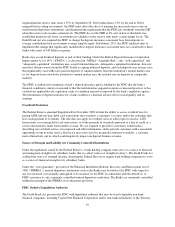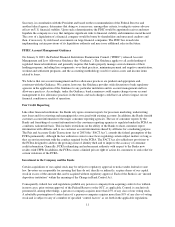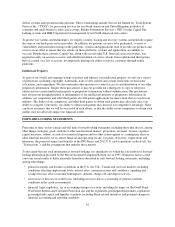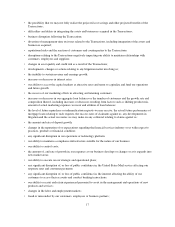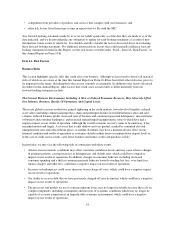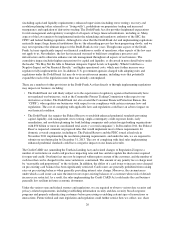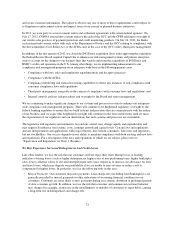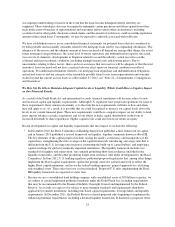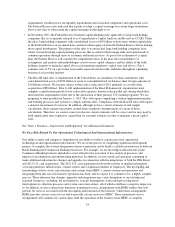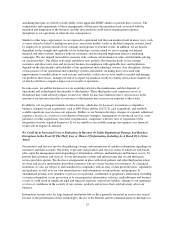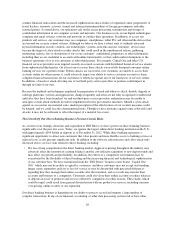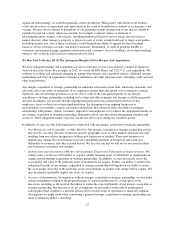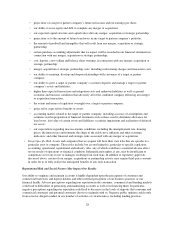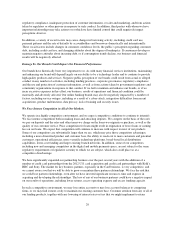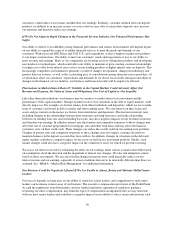Capital One 2012 Annual Report Download - page 39
Download and view the complete annual report
Please find page 39 of the 2012 Capital One annual report below. You can navigate through the pages in the report by either clicking on the pages listed below, or by using the keyword search tool below to find specific information within the annual report.(including capital and liquidity requirements), enhanced supervision (including stress testing), recovery and
resolution planning (often referred to as “living wills”), prohibitions on proprietary trading and increased
transparency and regulation of derivatives trading. The Dodd-Frank Act also provides heightened expectations
for risk management and regulatory oversight of all aspects of large financial institutions, including us. Many
aspects of the law remain to be implemented under the rulemaking and regulatory authority of the SEC, the
CFTC and federal banking regulators. Although it is clear that the Dodd-Frank Act and implementing regulations
materially impact large financial institutions like us, the rulemaking process has been progressing slowly, and we
may not experience the ultimate impact of the Dodd-Frank Act for years. Though some aspects of the Dodd-
Frank Act may significantly impact our financial condition or results of operations, other aspects of the law may
not apply to us. Nevertheless, the law has increased our need to build new compliance processes and
infrastructure and to otherwise enhance our risk management throughout all aspects of our business. The
cumulative impact includes higher expectations for capital and liquidity, as discussed in more detail below under
the header “We May Not Be Able to Maintain Adequate Capital Levels or Liquidity, Which Could have a
Negative Impact on Our Financial Results,” and higher operational costs, which may further increase once
regulators fully implement the law. In addition, U.S. government agencies charged with adopting rules and
regulations under the Dodd-Frank Act may do so in an unforeseen manner, including ways that potentially
expand the reach of the legislation more than was initially contemplated.
There are a number of other provisions in the Dodd-Frank Act that directly or through implementing regulations
may impact our business, including:
• The Dodd-Frank Act will likely subject us to the supervision of regulatory agencies that historically have
not regulated our businesses, such as the Commodity Futures Trading Commission with respect to our
derivatives activities. The Dodd-Frank Act also created the Consumer Financial Protection Bureau (the
“CFPB”), who regulates our businesses with respect to our compliance with certain consumer laws and
regulations. The cost of complying with applicable laws and regulations could have an adverse impact on
our financial condition.
• The Dodd-Frank Act requires the Federal Reserve to establish enhanced prudential standards governing
capital, liquidity, risk management, stress testing, single-counterparty credit exposure limits, early
remediation, and resolution planning for bank holding companies and certain foreign banking organizations
with $50 billion or more in consolidated total assets (“covered companies”). In December 2011, the Federal
Reserve requested comment on proposed rules that would implement most of these requirements for
domestic covered companies, including us. The Federal Reserve and the FDIC issued a final rule in
November 2011 implementing the resolution planning requirements, and under the rule, we are required to
submit our resolution plan by December 31, 2013. The cost of complying with final rules implementing
enhanced prudential standards could have a negative impact on our financial results.
The Credit CARD Act (amending the Truth-in-Lending Act) and related changes to Regulation Z impose a
number of restrictions on credit card practices impacting rates and fees and also update the disclosures required
for open-end credit. Overlimit fees may not be imposed without prior consent of the customer, and the number of
such fees that can be charged for the same violation is constrained. The amount of any penalty fee or charge must
be “reasonable and proportional” to the violation. In addition, the ability of a card issuer to increase rates charged
on pre-existing card balances has been significantly restricted. Card issuers are generally prohibited from raising
rates on pre-existing balances when generally prevailing interest rates change. Moreover, the circumstances
under which a card issuer can raise the interest rate on pre-existing balances of a customer whose risk of default
increases are restricted. As a result, the rules implementing the Credit CARD Act could make the card business
generally less resilient in future economic downturns.
Under the various state and federal statutes and regulations, we are required to observe various data security and
privacy-related requirements, including establishing information security and data security breach response
programs and properly authenticating customers before processing or enabling certain types of transactions or
interactions. Future federal and state legislation and regulation could further restrict how we collect, use, share
20


